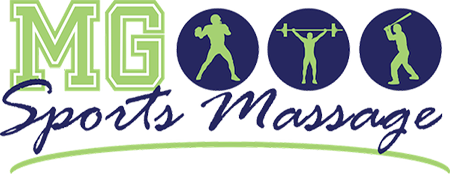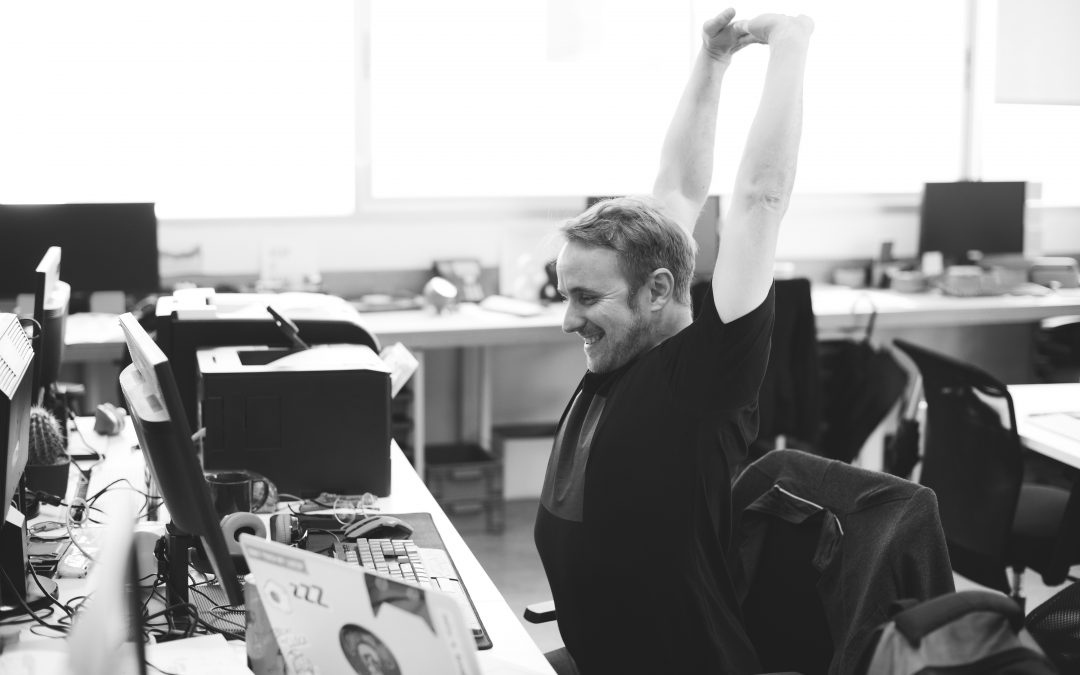Work which avoids physical labor is not absent of sore, stressed muscles.
About 80% of jobs in America are sedentary, meaning we’re strapped to our desks for a majority of the day, or our duties don’t involve heavy lifting.
We sit hunched over our keyboards, laptops, and phones, and it’s not going to take long to do damage to our health.
Musculoskeletal Disorders
The average American sits 13 hours each day, which leads to back problems, neck and shoulder pain, and fatigue. Lower back pain is a commonality and is listed to be the leading cause of disability. It’s already been estimated that 25% of young adults will end up on disability before retirement age.
Professional massage is a great solution to relieving the stress and tension in muscles caused by the strain of a sedentary position, but it’s not always possible to book an appointment in the middle of the workday. There are a few stretches that you can do to get temporary relief in the moment:
Quick Stretches
SPINAL OR TORSO TWISTS – Using the arms or back of your chair as leverage, sit up straight and rotate or twist your upper body to one side. Hold that position for 20-30 seconds, and then switch sides and repeat. This stretches your spine, neck, and chest.
NECK ROTATION – You’re probably feeling neck and shoulder tension by 2:00 if not sooner. For some relief, tip your head down and rotate your head to the left, holding 20-30 seconds; then do the same, tilting your head to the right. Also, try turning your head slowly from side to side in an upright position; aim to move your chin past your shoulder.
HUG YOUR BODY – The area between your shoulder blades is bound to get sore and tense when you spend your day hunched over typing or on a mobile device. For some quick relief, place your hands on the opposing shoulders. Deep breaths will expand the area, and the pressure on the joints will help to stretch the muscles.
As an added stretch, sit on the edge of your chair and bend in half, bringing your chest to your knees. Drop your neck and arms, and wrap your arms under your legs as if hugging them. This will stretch out your neck, shoulders, and back.
SHOULDER STRETCH
Soreness builds up in your shoulders just as much as in your back and neck. Hold one arm straight across your body, and use your opposite hand to pull it toward you. Hold it in place until you no longer feel the tight stretching.
SHRUG YOUR SHOULDERS
If you incorporate massage into your routine in any way, you may have noticed your therapist asking you to squeeze your shoulders toward your head, breathe deeply, and then release. This helps to relax your levator scapula muscles in your neck which cause pain in your neck and shoulders when tense. You can do a similar action at your desk (just without the relaxing-massage part).
UPPER SHOULDER AND NECK
Sit with one hand under your leg and tilt your head toward the opposite shoulder, angling your chin slightly forward. Repeat with the other side. You should start to feel stretching in both the back and front of your shoulders. Next, extend both arms above your head, interlocking your fingers; reach as high as possible.
Massage Therapy for Advanced Treatment
Stretches are fine as a temporary solution when you’re at work, but the relief is quick-lived.
Massage can help relax muscles to expel built-up tension from hours upon hours of sitting. It’s non-invasive and low risk for most people, making it an ideal solution.
It decreases tension as well as stimulates blood flow and circulation which aids in muscle recovery by bringing nutrients to the sore or injured tissue.
UPPER BACK
This is an area where tension abounds. It’s where your neck, shoulders, and spine all meet, so putting stress on any of those regions also deposits it here. Too much tension in this area can even cause back spasms. Much of this can be brought on by slouching and general computer work.
A massage therapist will use pressure on the upper back to break down muscular knots and decrease pain. Relief is also brought through stimulation of the lymphatic system; the heat of physical touch warms the muscles to soothe and relax them while also increasing blood flow.
LOWER BACK
The quadratus lumborum (QL) and gluteus medius are the two muscles in the lower back that can cause the most pain when strained, easily produced by slouching.
The lower back has a natural curvature to it that is supported by the abdominal muscles – something that becomes weakened from too much sitting or slouching. Slouching can also affect the alignment of the spine, putting more stress on the lower back.
Massage can assist in an increase of endorphins, the body’s feel-good chemical, which helps to manage chronic pain. Neuromuscular, or trigger point, massage is often used on lower back pain by applying consistent pressure directly on a spasm to relax it and increase blood flow for fewer attacks.
SHOULDERS
Thanks to our time sitting down, hovering over our keyboards, our range of motion decreases over time, causing stress on our shoulders.
Shoulder massage will help to increase mobility. Extending the range of motion aids in preventing future strain on shoulder muscles.
Adhesions, more commonly referred to as knots, run rampant in this area causing pain and discomfort. The pressure from massage breaks these up for relief and extended mobility.
NECK
There’s a reason we use the phrase “pain in the neck;” and if you’ve had tension in your neck, you know what a pain it is.
When we stare at our laptops or cell phones, we’re angling our heads in a way that is unnatural and puts a lot of undue stress and pressure on our necks.
Massage is a great way to relieve the tension that develops. Doing it yourself with your hand on your opposing shoulder may help briefly, but a massage therapist knows how to treat it better for extended periods of time. Getting a massage regularly also keeps joints relaxed, so you have less of a chance of pulling or irritating a muscle.
Those quick stretches are great for everyday, temporary relief to keep yourself from getting too stiff at your desk, but when you have a buildup of tension, nothing beats a professional massage. Contact us or schedule an appointment if you have any questions or need to relieve your stress.

